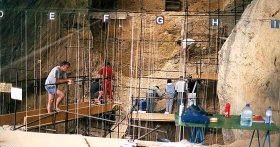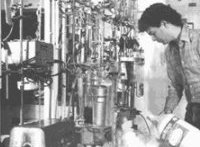what is fundamental to all research conducted by contemporary cultural anthropologists
Fields of Anthropology
At that place are now 4 major fields of anthropology: biological anthropology, cultural anthropology, linguistic anthropology, and archaeology. Each focuses on a different set of research interests and generally uses different research techniques. The methods range from those commonly used by the social sciences and humanities to those of biology and geology. Biological anthropology and archaeology are generally the closest to the biological and concrete sciences in methods and approach to learning about the human feel.
Biological Anthropology
Biological (or physical) anthropologists carry out systematic studies of the non-cultural aspects of humans and near-humans. Non-cultural refers to all of those biological characteristics that are genetically inherited in contrast to learned. Near-human is a category that includes monkeys, apes, and the other primates as well as our fossil ancestors. The primary interest of most biological anthropologists today is human evolution--they desire to learn how our ancestors inverse through time to become what nosotros are today. Biological anthropologists also are interested in understanding the mechanisms of evolution and genetic inheritance as well equally human variation and adaptations to different environmental stresses, such as those plant at high altitudes and in environments that have temperature extremes.
Biological anthropologists are normally involved in one of three different areas of research: human biology, primatology, or paleoanthropology. Human biology is concerned with learning virtually homo diversity, genetic inheritance patterns, non-cultural adaptations to environmental stresses, and other biological characteristics of our species, Homo sapiens  | Paleoanthropologists searching for fossils and artifacts of our distant human ancestors in a French cave | |
Cultural Anthropology
Cultural (or socio-cultural) anthropologists are interested in learning virtually the cultural aspects of human societies all over the world. They ordinarily focus their research on such things as the social and political organizations, marriage patterns and kinship systems, subsistence and economic patterns, and religious beliefs of different societies. Most cultural anthropologists study gimmicky societies rather than aboriginal ones. Through the 19th and nearly of the 20th centuries, the peoples who primarily interested cultural anthropologists were those who lived in minor, isolated societies with cultures that were very unlike from those of Europeans and European Americans. African, American Indian, and Pacific Island societies were often the subject of their research. Today, they are equally likely to study subcultures of modernistic, big-calibration societies such as Southeast Asian Hmong families now living in St. Paul, Minnesota, Mexican neighborhoods in Southern California, or bourgeois Onetime Order Amish communities in rural Pennsylvania.
 | An American subculture--the Erstwhile Order Amish of rural Pennsylvania | |
| |
We are living in a flow of unprecedented social and cultural change around the globe, and the rate of change is accelerating equally a issue of our rapid population growth and technological invention, especially in transportation and communication. All of the completely isolated societies of the past have long since been fatigued into the global economy and heavily influenced by the ascendant cultures of the large nations. Every bit a consequence, it is likely that iii/iv of the languages in the world today will become extinct equally spoken languages past the finish of the 21st century. Many other cultural traditions will exist lost as well. Cultural and linguistic anthropologists have worked diligently to report and sympathize this diverseness that is being lost.
Linguistic Anthropology
| | |
| An example of nonverbal communication in modern American culture. What do you lot call back the chief petty officer (in khaki) is communicating non-verbally to the sailor in this scene? |
Linguistic anthropologists ![]() study t he human being communication process. They focus their enquiry on agreement such phenomena as the physiology of speech, the structure and office of languages, social and cultural influences on speech and writing, nonverbal communication, how languages adult over time, and how they differ from each other. This is very different from what goes on in an English language or a foreign linguistic communication form. Linguists are not language teachers or professional translators.
study t he human being communication process. They focus their enquiry on agreement such phenomena as the physiology of speech, the structure and office of languages, social and cultural influences on speech and writing, nonverbal communication, how languages adult over time, and how they differ from each other. This is very different from what goes on in an English language or a foreign linguistic communication form. Linguists are not language teachers or professional translators.
Well-nigh anthropological linguistic research has been focused on unwritten, non-European languages. Linguists usually begin their study of such a linguistic communication by learning first paw from native speakers what its rules are for making sounds and meaning from those sounds, including the rules for sentence construction. Linguists too larn about dissimilar regional and social dialects also as the social conventions of speaking the language in dissimilar situations.
A hotly debated question in linguistic anthropology since the early on 20th century centers on whether or non our languages predispose us to see the environment in specific means. In other words, are languages filters for reality? For example, if a language does not have a word for the color orange, tin its speakers distinguish orange from carmine and yellow? The answer to this question is non as simple as information technology initially seems.
Archeology
Archaeologists are interested in recovering the prehistory and early on history of societies and their cultures. They systematically uncover the show past excavating, dating, and analyzing the textile remains left past people in the past. Archaeologists are essentially detectives who search through many thousands of pieces of bitty pots and other artifacts every bit well as environmental data in social club to reconstruct ancient life means. In a sense, this makes archaeology the cultural anthropology of the past. Archæology is as well related to biological anthropology in its use of the same methods in excavating and analyzing human skeletal remains found in archaeological sites.
Archaeologists are in a unique position to understand the development of homo societies and cultures from those of our afar hunter gatherer ancestors through the ancient civilizations on up to the nowadays. There have been humans for at least two.five million years. Merely the last v,500 of these years have been even partly recorded past scribes and historians. As a outcome, well over 99% of the human story lies in the prehistoric past and has been out of achieve of historians. Merely archaeology can recover information technology.
No archaeologist is an expert on the antiquity of all regions of the world and all time periods. Classical archaeologists concentrate on the ancient civilizations of the Middle Due east and the Mediterranean world (Arab republic of egypt, Mesopotamia, Greece, Rome, and related peoples). Historical archaeologists work on recovering the unrecorded aspects of life in historically more modern societies such as colonial America. Prehistoric archaeologists focus their attention on the more aboriginal pre-literate societies around the world including those of most early North American Indians. Underwater archaeologists notice and excavate ancient shipwrecks and submerged cities. Zooarchaeologists ![]() analyze and interpret the animal remains found in archaeological sites. The training required for each of these and other archeological specialties varies significantly, but they all share an interest in elucidating the lost past.
analyze and interpret the animal remains found in archaeological sites. The training required for each of these and other archeological specialties varies significantly, but they all share an interest in elucidating the lost past.
 |  |  | ||
| Archaeologists mapping and excavating an ancient building in Rome | Archaeologist at work in | Underwater archaeologist |
Notation: In British universities, archaeology is commonly considered to be a separate academic bailiwick, distinct from anthropology. This is peculiarly truthful of classical and historical archæology.
The Application of Anthropological Knowledge and Methods
Most anthropologists behave out research and teach most what they have learned. They are employed by universities, colleges, and museums. Withal, a 3rd of all anthropologists use this knowledge and methodology of problem solving for practical purposes in corporations, government agencies, non-governmental organizations, medical institutions, and other not-academic settings. They are applied anthropologists. It is probable that there will be continued growth in the number of these non-academic jobs.
Some applied cultural anthropologists piece of work as researchers, administrators, implementers, or mediators in major corporations. They help the companies understand and deal more than efficiently with employees and customers from diverse cultures and subcultures. There have even been anthropologists working in the White House and U.Southward. Congress studying the overall operations and personal interactions. In contempo years, some cultural anthropologists have worked for the U.S. military and NATO in Afghanistan to aid them improve understand the cultural realities of the peoples of that region. A few cultural anthropologists have been hired by Native American tribes and other indigenous groups to aid them with customs evolution and to propose them in their interactions with the outside world.
Many archaeologists in the United States and some other countries apply their skills in cultural resource management specialist jobs. They are employed past the National Park and Wood Services, the U.South. military machine, and other government agencies as well every bit private companies to prevent or mitigate the devastation of archaeological sites and other important cultural resource. They record the locations of unknown archaeological sites and carry out sample excavations to make up one's mind their cultural significance and to recommend measures for preservation or farther study before they are destroyed past construction projects.
Forensic anthropologists ![]() are employed around the globe principally by police, courts, and international organizations to identify murder and disaster victims. They practice this mostly from skeletal remains and Dna. Forensic anthropologists also work for the U.S. armed services to recover and identify the remains of soldiers.
are employed around the globe principally by police, courts, and international organizations to identify murder and disaster victims. They practice this mostly from skeletal remains and Dna. Forensic anthropologists also work for the U.S. armed services to recover and identify the remains of soldiers.
| | |
| Many drugs used in modern Western medicine were derived from plants used by folk curers. Ethnobotanists help discover new ones. |
Medical anthropologists learn about cultural differences in explaining what causes illness and what people from different cultures believe is acceptable every bit treatment. The germ theory and the idea that illness is not due to supernatural causes are widely accepted by educated people in the Western Earth and areas that accept adopted our medical organization. Notwithstanding, much of the rest of the world has very unlike explanations. Medical anthropologists can aid doctors and nurses understand how to amend communicate with and treat patients who hold these other explanations. Medical anthropologists also are interested in the epidemiology of illnesses--that is their causes and how they can be cured or controlled.
Some cultural anthropologists work with indigenous peoples in out of the style parts of the world, such every bit the Amazon Bowl, in order to discover unknown plants and their uses. These researchers are ethnobotanists ![]() . Some of them concentrate on finding new potential medicines from among the plants used by these peoples.
. Some of them concentrate on finding new potential medicines from among the plants used by these peoples.
Copyright � 2009-2012 by Dennis O'Neil . All rights reserved.
analogy credits
whitsonmysecutage.blogspot.com
Source: https://www2.palomar.edu/anthro/intro/fields.htm


0 Response to "what is fundamental to all research conducted by contemporary cultural anthropologists"
Publicar un comentario